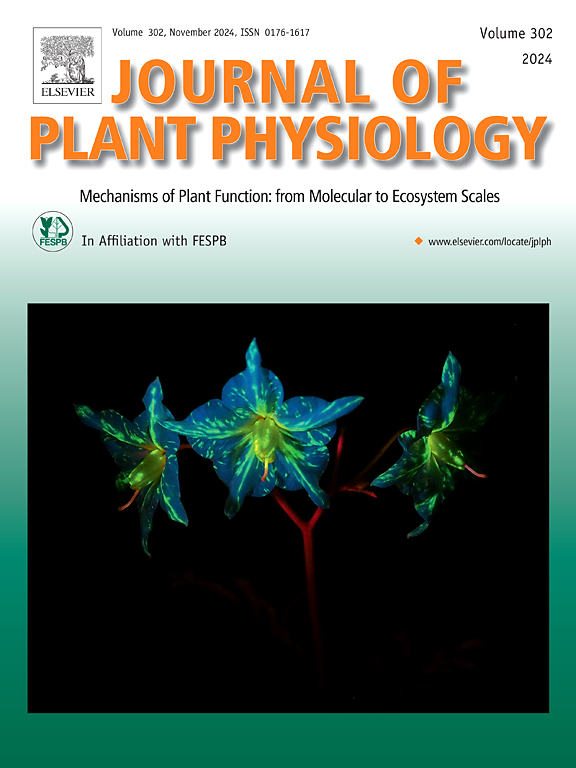Partial replacement by ammonium nutrition enhances Brassica napus growth by promoting root development, photosynthesis, and nitrogen metabolism
IF 4
3区 生物学
Q1 PLANT SCIENCES
引用次数: 0
Abstract
Nitrogen (N) is crucial for plant growth, available primarily as nitrate (NO3−) and ammonium (NH4+). However, its presence in soil is often limited, necessitating strategies to augment N availability. This study delves into the enigmatic interplay between NO3− and NH4+ in fostering the growth of Brassica napus, an important oil crop worldwide. Here, we examined the growth responses of 49 B. napus varieties to five NH4+:NO3− ratios (12:0, 9:3, 3:9, 1:11, 0:12). In general, the biomass of 49 rapeseed varieties increased with the decrease of NH4+ to NO3− ratios in the growth environment. However, different varieties may respond diversely to the mixed N sources, or sole NO3− or NH4+ condition. For some cultivars, the mixed N supply significantly enhanced the plant growth compared with the sole NO3− conditions. Thus, we further investigate the morphological, physiological and molecular response of rapeseed to the mixed N source condition using sole NO3− as a control. The results show that partial replacement by ammonium nutrition in the environment can promote rapeseed root development, net photosynthetic rate and NO3− reduction compared to NO3−-only conditions. Using transcriptome analysis, we found a total of 399 and 465 genes which were differentially expressed in root and shoot under A1N11 compared to A0N12 treatments, respectively. Genes involved in photosynthesis, N uptake and assimilation were upregulated by mixed N supplies. These findings highlight that the mixed N supply primarily stimulates B. napus growth by enhancing root development, photosynthesis and N metabolism in the shoot. Such insights are crucial for optimizing N form selection in B. napus to enhance plant performance and N use efficiency.
铵营养的部分替代通过促进根系发育、光合作用和氮代谢来促进甘蓝型油菜的生长。
氮(N)对植物生长至关重要,主要以硝酸盐(NO3-)和铵(NH4+)的形式存在。然而,它在土壤中的存在往往是有限的,需要策略来增加氮的可用性。本研究探讨了NO3-和NH4+在促进甘蓝型油菜生长中的神秘相互作用。以49个甘蓝型油菜品种为研究对象,研究了5种NH4+:NO3-配比(12:0、9:3、3:9、1:11、0:12)对甘蓝型油菜生长的影响。总体而言,49个油菜品种的生物量随着生长环境中NH4+ / NO3-比值的降低而增加。然而,不同品种对混合氮源或单一NO3-或NH4+条件的响应不同。对部分品种而言,混施氮肥比单施NO3-显著促进植株生长。因此,我们以单一NO3-为对照,进一步研究了油菜籽对混合氮源条件的形态、生理和分子响应。结果表明,与只施用NO3——相比,环境中铵态营养的部分替代能促进油菜籽根系发育、净光合速率和NO3-减量。通过转录组分析,我们发现A1N11处理与A0N12处理相比,根和茎中分别有399个和465个基因差异表达。与光合作用、氮吸收和同化有关的基因在混合氮供应下上调。这些结果表明,混合氮供应主要通过促进根系发育、光合作用和地上部氮代谢来促进甘蓝型油菜的生长。这些见解对于优化甘蓝型油菜氮素形态选择以提高植株性能和氮素利用效率至关重要。
本文章由计算机程序翻译,如有差异,请以英文原文为准。
求助全文
约1分钟内获得全文
求助全文
来源期刊

Journal of plant physiology
生物-植物科学
CiteScore
7.20
自引率
4.70%
发文量
196
审稿时长
32 days
期刊介绍:
The Journal of Plant Physiology is a broad-spectrum journal that welcomes high-quality submissions in all major areas of plant physiology, including plant biochemistry, functional biotechnology, computational and synthetic plant biology, growth and development, photosynthesis and respiration, transport and translocation, plant-microbe interactions, biotic and abiotic stress. Studies are welcome at all levels of integration ranging from molecules and cells to organisms and their environments and are expected to use state-of-the-art methodologies. Pure gene expression studies are not within the focus of our journal. To be considered for publication, papers must significantly contribute to the mechanistic understanding of physiological processes, and not be merely descriptive, or confirmatory of previous results. We encourage the submission of papers that explore the physiology of non-model as well as accepted model species and those that bridge basic and applied research. For instance, studies on agricultural plants that show new physiological mechanisms to improve agricultural efficiency are welcome. Studies performed under uncontrolled situations (e.g. field conditions) not providing mechanistic insight will not be considered for publication.
The Journal of Plant Physiology publishes several types of articles: Original Research Articles, Reviews, Perspectives Articles, and Short Communications. Reviews and Perspectives will be solicited by the Editors; unsolicited reviews are also welcome but only from authors with a strong track record in the field of the review. Original research papers comprise the majority of published contributions.
 求助内容:
求助内容: 应助结果提醒方式:
应助结果提醒方式:


